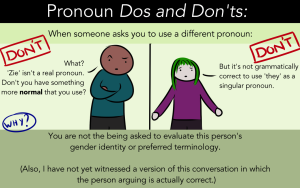
Source: iStock
“Of course I care about women, but I believe in science too much to be a feminist.”
“Feminists can deny it all they want, but science has proven that men and women are fundamentally different.”
“This study just came out – now finally maybe the feminists will stop arguing with science!”
If you’re hearing statements like this, you’re talking to someone who’s bought into the lie that feminism and science contradict each other.
It might not be “politically correct,” they’ll say, but there’s just too much scientific evidence against feminism. They’ll position themselves as hard realists – and paint feminism as naive and deluded.
The deeper you dig into their reasoning, though, the more fuzzy and illogical it gets.
For example, “men and women are exactly the same” is not a key argument of feminism in the first place. Different feminists have different beliefs about the nature of gender, and how biology and socialization impact men, women, and people of other a/genders.
What feminism does argue is that our culture unfairly privileges men over women and people of other a/genders, and that we need to take deliberate steps to correct this.
And yet, the “feminism is anti-science” people come back with “but men and women are different!” as if that’s a relevant argument.
Then there’s the evidence itself. I love science and research – which means I hate a lot of what gets reported in “scientific” news articles. Research, if it’s done right, gives tiny bits of insight that need to be interpreted carefully in the context of a bigger picture.
But nuance and context don’t make for very attention-grabbing headlines, though. So a study that suggests a modest correlation between, say, having blonde hair and liking to play ping-pong, may get reported as “BLONDES ARE HARD-WIRED TO PREFER PING-PONG! SCIENCE SAYS SO.”
Good scientific research can tell us a lot of important things about sex and gender. But when a study’s results are taken out of context, or sensationalized, there’s a danger that our culture’s biases and stereotypes about gender will be reinforced with a great big “SCIENCE SAYS SO” button – even if the science doesn’t really say that at all.
When it comes to sex and gender research, there are several traps that science reporting often falls into.
So the next time someone shows you an article that’s supposed to “disprove” feminism, try asking these four questions.
1. Does the Brain Reveal Nature or Culture?
Brain studies are very appealing to people who want to argue that our world’s gender inequality is actually due to fundamental gender differences.
They’ll argue that there are more men in science and math because men’s brains are better designed for those technical fields. They’ll argue that women do more domestic and emotional labor because their brains are better designed for that kind of work.
Some will even argue that feminism is bad for women – because women are naturally designed to be happy in submissive and caretaking roles.
And often they use brain studies to back up these arguments.
If we find basic differences between the brains of (cisgender) men and women, they say that this proves that any differences between men’s and women’s roles in society comes from their basic brain structure. (And as we’ll see in a minute, most researchers completely ignore non-binary people when looking at sex and gender.)
But let’s examine that assumption more closely.
Suppose a study comes out saying the Platypus Cortex in adult men is twice as big as the Platypus Cortex in adult women, and that the Platypus Cortex is associated with an ability to sense where lightning is about to strike.
It’s also true (in this imaginary world where the Platypus Cortex is a thing) that men are stereotypically better at sensing impending lightning strikes.
Does the study prove that:
A. Men’s ability to sense lightning strikes is biologically determined
B. Men’s ability to sense lightning strikes is socially conditioned
C. Women are actually naturally better at sensing lightning strikes than men
D. Any or all of the above
Surprise! It’s D.
Studies that show an overall sex difference in brain structure don’t, by themselves, prove anything about whether the difference in abilities comes from nature or cultural conditioning or both.
It’s easy to assume they do: Your Platypus Cortex is bigger so, therefore, you must be naturally more gifted at whatever the Platypus Cortex does! But what’s missing is the way nature and nurture are constantly working together.
Your brain isn’t just built a certain way from birth. Your brain changes and grows. New nerve pathways are built, based on the thoughts and feelings and actions that you have most often. Nerve pathways that you don’t use much fade away.
For example, a study showed that London taxi drivers had more gray matter in an area of the brain that deals with remembering spatial navigation information. The longer they had worked as a taxi driver, the bigger this difference was.
Your adult brain is a picture of how nature and nurture have worked together to create the person you are.
Another thing that’s tricky about brain-based claims is that very few activities and skills belong to just a single part of the brain. It’s way more complicated than that. And in some cases, an overgrown Platypus Cortex could mean that male brains are working hard to compensate for a natural advantage in women’s abilities (which would be option C above).
Right now, in neuroscience, there are many more questions than answers. I’m all for continuing to study our brains, but we need to remain open-minded about what our results actually mean.
2. Who Is Being Studied?
If you’re going to do a psychological study, you need a lot of people who are willing to participate. And what’s the easiest way for a psych researcher to recruit study participants? Get the undergrads in their university psychology program to do it!
If you pull a pile of behavioral research studies, you’ll probably find that a massive proportion of them are on college students. And as those students should be able to tell you, since they study psychology and all, you can’t generalize from one group to another when there are notable differences between those groups.
One thing we know for sure about gender is that it’s profoundly shaped by culture. And if we’re primarily studying one cultural group, we’re missing a lot.
And yet, scientific news will give us headline after headline about how “men” and “women” have been shown to behave differently, when the actual studies only show differences between educated, disproportionately white people in their teens and early twenties.
Even with studies that don’t use college students, study participants tend to be whiter, more educated, and more financially well off than the population as a whole.
Even when the researchers want to recruit a diverse sample, there are a lot of barriers to doing so: economic burdens, language barriers, and a history of appalling racism in scientific research that makes many people of color and other vulnerable groups justifiably distrustful of researchers.
And forget about gender and sexual diversity. If you’re seeking to understand the nature of sex and gender, then you can’t ignore transgender, intersex, and non-binary people. And yet, most studies of gender only include cisgender men and women. If a study is going to include other sexes or genders, it’s probably because it’s predominantly about those areas of diversity.
We can’t draw major conclusions about fundamental differences from observing a handful of straight, cisgender, highly-educated twenty-year-olds. Don’t trust anyone who tries to tell you different.
3. Where Are the Null Results?
Suppose you’re a sociologist running a study to ask, “Do men and women respond differently to emotions on a stranger’s face?”
You do all of your experiments and crunch all the numbers, and turns out – the answer is no! Your study shows that men and women basically have the same responses to a variety of emotions shown by a stranger.
Your question has been answered, but not in a way that makes for exciting science news. But “Nope, didn’t find anything there” is a lot of what goes on in the day-to-day practice of science.
And most of those “Nope, didn’t find anything” studies don’t get published.
Even if they do get published, you’re not going to see popular science journalism reporting on them, because that’s not a good headline. So people outside of the field will never know about them.
But maybe nineteen other researchers are running similar studies, in departments all over the world. And most of them find the same result you do – that is, no result – but one of them does find that women respond more strongly to strangers’ emotions than men do.
Maybe they ran their study a little differently, maybe they just happened to get a sample of people where this was true (which is always a possibility with research), or maybe even there were some methodological issues with how their study was carried out.
But out of all twenty of you, the only one whose study gets published was the one that found a result. And then a month later, you see headlines: “Science proves that women are more empathetic than men!”
This is a pretty common problem. Studies that find differences will get published and reported on – while studies that don’t, won’t.
And it means that “the science of gender” is very literally biased toward finding differences between men and women.
So before you believe a “scientific” claim about sex and gender, try to find other studies that back up the one being reported on. The more independent studies there are that can confirm the effect, the more likely it’s a real difference.
4. Is It Science or Storytelling?
When we hear words like “evolutionarily adapted,” it certainly sounds like we’re taking scientifically. And sometimes we are.
Often, though, those words are a hint that what’s going on here is little more than modern myth-making.
Evolutionary psychology attempts to gain insight about humans today by considering the environment our brains and bodies evolved in.
The basic idea is fine: Qualities that helped us survive and procreate when humans were being formed as a species are likely to still be with us, and looking at those early dynamics of survival might help us understand why we are the way we are.
The problem with evolutionary psychology is that it involves a lot of guesswork.
We don’t have much information about what primordial humans were actually like. From sketchy archaeological and anthropological clues, we can cobble together an idea, but it’s like putting together a puzzle when you only have a fraction of the pieces.
The image that emerges is as much a function of our imagination as a reflection of the reality.
So what happens when we try to use evolutionary psychology to explain gender issues?
Here’s one example: Men and women are fundamentally different, the anti-feminist “science” advocate will say. Men evolved to be hunters and warriors, and to protect their families from enemies and predators. Women evolved to raise the children, and to depend on the men for provisions and protection.
The ideal survival arrangement was to have men who are bold, strong, and aggressive, and women who are nurturing and good at creating emotional attachments with their male partners. So men and women are “hard-wired” to have different roles and different strengths, and feminism is just attempting to deny that reality.
This story sounds plausible, but it leaves out a lot of possibilities.
What if, in these primordial human tribes, women instead of men were the primary providers of food?
What if tribes were collectivist, so that rather than depending on a single male protector and provider, children and weaker tribe members depended on the stronger tribespeople as a group?
What if paternity wasn’t really understood, so men would have no reason to defend “their” child over any of the other children in the tribe?
What if early humans recognized more than two genders?
Any of those possibilities are likely – some are more likely than not. And they would paint a very different picture of the “natural” relationships between genders.
Yet somehow, when people try to explain gender on the basis of evolution, they tend to revert to our current assumptions and stereotypes.
Even in the most rigorous disciplines, the scientific method can’t completely remove human error and human bias. And evolutionary psychology is anything but rigorous.
It draws a connection from what we think we observe in the present to what we imagine to have happened in the past. It’s perfectly designed to reflect our biases and unproven beliefs – just like any myth.
***
When it comes to sex and gender, there are still a whole lot of unknowns. Science has a long history of jumping to conclusions about how inequality is just built into our brains and bodies.
Just because we’ve moved beyond ideas like “the wandering uterus” or “women’s brains are smaller, therefore they’re less intelligent” doesn’t mean we’re immune to repeating those mistakes on the cutting edge of research.
What we do know for sure is that the cultural pressures and power dynamics of today’s world have a massive impact on how people view themselves and interact with others.
Feminism argues that we should be paying attention to those pressures and power dynamics, and working to balance them out so that people of all genders can have equal respect and opportunities.
And no credible interpretation of science that can say that that’s wrong.
[do_widget id=’text-101′]
Ginny Brown is a Contributing Writer for Everyday Feminism, as well as a speaker and educator specializing in sexuality and relationships. She writes for various publications and has her own blog here. She lives in the Philadelphia area with her poly family and three cats. Follow her on Twitter @lirelyn.
Search our 3000+ articles!
Read our articles about:
Our online racial justice training
Used by hundreds of universities, non-profits, and businesses.
Click to learn more




















